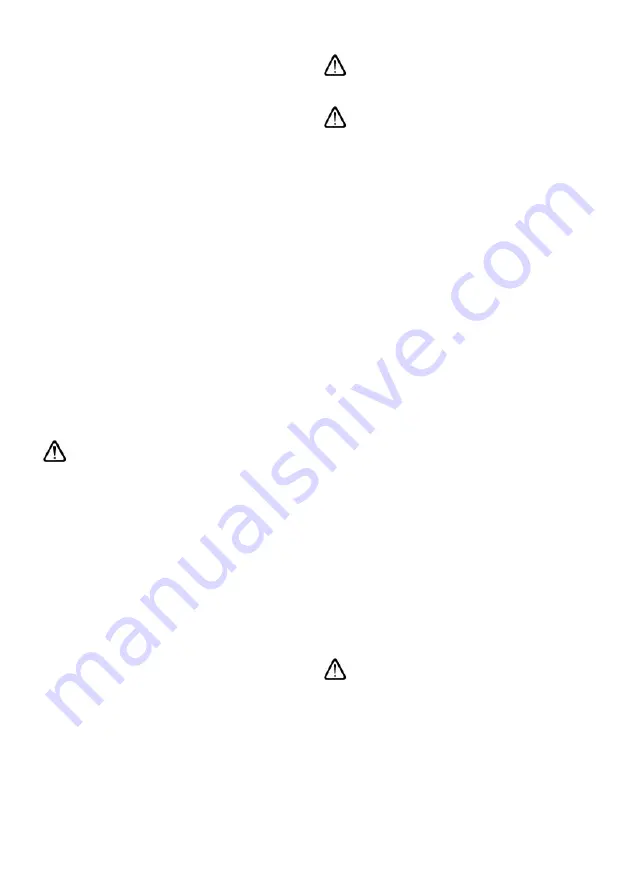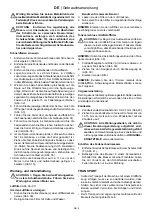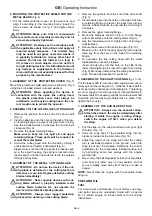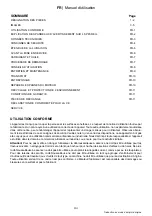
GB-8
GB
|
Operating Instruction
shrubs and that the impact of the nylon line against the
trunk of bushes or trees with soft bark could seriously
damage the plant.
Clearing
When mowing away, you capture the whole vegetation
down to the ground. To do so tilt the cutting head to the
left with an angle of 30 degrees. Adjust the handle to the
desired position. Be aware of the higher danger of injuries
for the operator, surrounding persons and animals, and
the danger of damages to property through hurled-away
objects (e.g., stones) (Fig. 26).
CUTTING WITH THE CUTTING BLADE
(Fig. 25)
When cutting with the cutting blade, always wear protec-
tion goggles, face protection, protection clothes, and use
the shoulder strap.
Start cutting above the under growth and then move
down with the scything blade so as to cut the brush into
small pieces.
SCYTHING
(Fig. 26)
Proceed at a regular pace, with a circular motion similar
to a traditional scythe, without tilting the cutting line head
during the operation.
First try cutting at the right height in a small area, so as to
then achieve a uniform cutting height keeping the cutting
line head at a constant distance from the ground.
For heavier cutting it can be useful to tilt the cutting line
head by about 30°.
WARNING! Do not work in this way if there is
the possibility of causing objects to be thrown,
which could harm people and animals and
cause damage.
IF THE CUTTING DEVICE GOT STUCK
Shrubs and trees may jam the cutting blade and cause
the blade to stop. Avoid the blade from getting stuck by
cutting through appropriate undergrowth and brushwood
from changing sides. If the cutting blade should, how-
ever, got stuck stop the engine immediately. Hold the
device up an avoid that the cutting blade deformed by
bending or even breaks when you push the brushwood
to be cut away from the cutting blade.
AVOIDING KICKBACKS
When using metal cutting tools (thicket blade) there is
the danger of kickbacks if the tool gets in touch with
some solid object (tree trunks, branches, stones etc.). If
this should happen, the device is “kicked“ or thrown back
against the turning direction of the tool. This may lead to
the loss of control over the tool and to the danger of injury
for the operator and people nearby!
Do not use metal cutting tools near fences, metal
posts, boundary stones, or foundations.
Extending the cutting cord
To extend the cutting cord let the engine run at full throttle
and bump the cutting head (1) on the ground. The cord is
automatically extended. The cutter at the protection cover
cuts the cord to the required length (Fig. 28).
Important note: Do not use metal wire or plas-
tic-sheathed metal wire of any kind in the cutting
head. This may lead to serious injuries of the
operator.
ATTENTION: Regularly remove any remainders
of grass and weed to avoid an overheating of
the shaft tube. Remainders of grass and weeds
get caught under the protection cover (Fig. 29)
avoiding a sufficient cooling of the shaft tube.
Remove the remainders carefully with a screw-
driver or a similar tool.
Replacing the cutting cord
1. Remove the screw by turning it clockwise (Fig. 30).
2. Remove the coil and spring from the spindle (Fig. 30).
3. Remove the remaining cutting cord.
4. Fold a 6 m x 2,0 mm cord in half. Put the loop end into
the slot of the spool (Fig. 31). The slot is located in the
centre wall that divides the two cord chambers from
each other.
5. Roll both halves of the cord concurrently around
the spool. The wrapping direction is engraved in the
spool: “Wind Cord”. Make sure that the cord is always
tensioned and that each half of the cord stays in the
proper separate spool housing. Roll up the cord until
15 cm of cord remain at each end (Fig. 32).
6. Lead each cord end through the openings at the re-
spectively opposite side of the coil (Fig. 33).
7. Lead the spring over the spindle and thread the cord
ends through the eyelets in the housing (Fig. 34).
8. Lead the coil into the housing while pulling the cord
ends through the eyelets. Make sure that the spring is
positioned correctly in relation to the coil and housing
(Fig. 34).
9. When the coil sits in its correct position in the housing,
push it firmly into the housing so that the spring is ten
-
sioned. Firmly pull at both ends of the cord so that the
cord cannot be pinched between the coil and housing.
Maintain the spring tension through continuous pres-
sure on the coil in the housing and fix the screw by
turning it anticlockwise. Fasten the screw fingertight
only (Fig. 35).
10. Cut the cord to about 17 cm to avoid excessive load
to the engine during the starting and warm-up phase
(Fig. 15).
MAINTENANCE AND REPAIR
ATTENTION! Always wear protective gloves
when carrying out maintenance work. Never
perform maintenance works with the engine still
being hot.
AIR FILTER
(Fig. 36+37)
To clean the air filter:
1.
Remove the fixing screw (x) of the air filter cover (Fig.
36).
2. Clean the filter using soap and water.
Never use petrol or benzene !
3. Let the Filter dry in the air.
4. Now put the filter in again proceeding the other way
round.
Содержание IBF 25-1
Страница 5: ...4 21 16 15 17 cm 18 16 19 11 9 12 20 13 14 4 12 13 10 4 1 3 2 11 2 17 17 17 20 21 21...
Страница 6: ...5 31 26 27 29 30 28 1 23 25 32 33 22 24...
Страница 7: ...6 41 38 39 A 35 40 0 6 0 7 mm 37 34 X 36...
Страница 62: ......
Страница 74: ......
Страница 78: ......
Страница 79: ......
















































